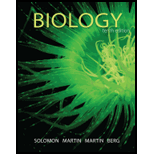
Biology (MindTap Course List)
10th Edition
ISBN: 9781285423586
Author: Eldra Solomon, Charles Martin, Diana W. Martin, Linda R. Berg
Publisher: Cengage Learning
expand_more
expand_more
format_list_bulleted
Concept explainers
Question
Chapter 32.5, Problem 5LO
Summary Introduction
To describe: Four shared derived characters of vertebrates.
Concept introduction: Animal phylogeny is the rapidly changing field for the biologists. Even if the members of the animal kingdom are incredibly diverse, there are various animals sharing certain features that differentiate them from other organisms of the kingdom. Chordates are the deuterostomes. They are coelomates with a bilateral symmetrical body structure. Chordates are divided into three clades, namely urochordates, cephalochordates, and vertebrates.
Expert Solution & Answer
Want to see the full answer?
Check out a sample textbook solution
Students have asked these similar questions
What symbolic and cultural behaviors are evident in the archaeological record and associated with Neandertals and anatomically modern humans in Europe beginning around 35,000 yBP (during the Upper Paleolithic)?
Describe three cranial and postcranial features of Neanderthals skeletons that are likely adaptation to the cold climates of Upper Pleistocene Europe and explain how they are adaptations to a cold climate.
Biology Question
Chapter 32 Solutions
Biology (MindTap Course List)
Ch. 32.1 - Prob. 1LOCh. 32.1 - Prob. 1CCh. 32.2 - Prob. 2LOCh. 32.2 - Prob. 1CCh. 32.2 - Prob. 2CCh. 32.3 - Describe characteristics of chordates, including...Ch. 32.3 - What are four shared derived characters of...Ch. 32.3 - Prob. 2CCh. 32.3 - Prob. 3CCh. 32.4 - Prob. 4LO
Ch. 32.4 - Prob. 1CCh. 32.4 - If you found a small fishlike animal along the...Ch. 32.5 - Prob. 5LOCh. 32.5 - Prob. 6LOCh. 32.5 - Prob. 1CCh. 32.5 - Prob. 2CCh. 32.6 - Prob. 7LOCh. 32.6 - Prob. 1CCh. 32.6 - Prob. 2CCh. 32.7 - Prob. 8LOCh. 32.7 - Prob. 1CCh. 32.7 - Prob. 2CCh. 32.8 - Describe three vertebrate adaptations to...Ch. 32.8 - Prob. 10LOCh. 32.8 - Prob. 11LOCh. 32.8 - Prob. 1CCh. 32.8 - Prob. 2CCh. 32.8 - Prob. 3CCh. 32.8 - Prob. 4CCh. 32 - Test Your Understanding 1.Which of the following...Ch. 32 - Test Your Understanding 2.Which of the following...Ch. 32 - Test Your Understanding 3.A shark is characterized...Ch. 32 - Test Your Understanding 4.Which of the following...Ch. 32 - Test Your Understanding 5.Reptiles (a) are all...Ch. 32 - Test Your Understanding 6.Which of the following...Ch. 32 - Test Your Understanding 7.Which of the following...Ch. 32 - Test Your Understanding 8.VISUALIZE Draw a simple...Ch. 32 - Test Your Understanding 9.EVOLUTION LINK Sea...Ch. 32 - Test Your Understanding 10.EVOLUTION LINK Most...Ch. 32 - Test Your Understanding 11.EVOLUTION LINK Discuss...Ch. 32 - Prob. 12TYUCh. 32 - Prob. 13TYU
Knowledge Booster
Learn more about
Need a deep-dive on the concept behind this application? Look no further. Learn more about this topic, biology and related others by exploring similar questions and additional content below.Similar questions
- ✓ Details Draw a protein that is embedded in a membrane (a transmembrane protein), label the lipid bilayer and the protein. Identify the areas of the lipid bilayer that are hydrophobic and hydrophilic. Draw a membrane with two transporters: a proton pump transporter that uses ATP to generate a proton gradient, and a second transporter that moves glucose by secondary active transport (cartoon-like is ok). It will be important to show protons moving in the correct direction, and that the transporter that is powered by secondary active transport is logically related to the proton pump.arrow_forwarddrawing chemical structure of ATP. please draw in and label whats asked. Thank you.arrow_forwardOutline the negative feedback loop that allows us to maintain a healthy water concentration in our blood. You may use diagram if you wisharrow_forward
- Give examples of fat soluble and non-fat soluble hormonesarrow_forwardJust click view full document and register so you can see the whole document. how do i access this. following from the previous question; https://www.bartleby.com/questions-and-answers/hi-hi-with-this-unit-assessment-psy4406-tp4-report-assessment-material-case-stydu-ms-alecia-moore.-o/5e09906a-5101-4297-a8f7-49449b0bb5a7. on Google this image comes up and i have signed/ payed for the service and unable to access the full document. are you able to copy and past to this response. please see the screenshot from google page. unfortunality its not allowing me attch the image can you please show me the mathmetic calculation/ workout for the reult sectionarrow_forwardIn tabular form, differentiate between reversible and irreversible cell injury.arrow_forward
- 1.)What cross will result in half homozygous dominant offspring and half heterozygous offspring? 2.) What cross will result in all heterozygous offspring?arrow_forward1.Steroids like testosterone and estrogen are nonpolar and large (~18 carbons). Steroids diffuse through membranes without transporters. Compare and contrast the remaining substances and circle the three substances that can diffuse through a membrane the fastest, without a transporter. Put a square around the other substance that can also diffuse through a membrane (1000x slower but also without a transporter). Molecule Steroid H+ CO₂ Glucose (C6H12O6) H₂O Na+ N₂ Size (Small/Big) Big Nonpolar/Polar/ Nonpolar lonizedarrow_forwardwhat are the answer from the bookarrow_forward
arrow_back_ios
SEE MORE QUESTIONS
arrow_forward_ios
Recommended textbooks for you
 Biology: The Dynamic Science (MindTap Course List)BiologyISBN:9781305389892Author:Peter J. Russell, Paul E. Hertz, Beverly McMillanPublisher:Cengage Learning
Biology: The Dynamic Science (MindTap Course List)BiologyISBN:9781305389892Author:Peter J. Russell, Paul E. Hertz, Beverly McMillanPublisher:Cengage Learning Concepts of BiologyBiologyISBN:9781938168116Author:Samantha Fowler, Rebecca Roush, James WisePublisher:OpenStax College
Concepts of BiologyBiologyISBN:9781938168116Author:Samantha Fowler, Rebecca Roush, James WisePublisher:OpenStax College Biology (MindTap Course List)BiologyISBN:9781337392938Author:Eldra Solomon, Charles Martin, Diana W. Martin, Linda R. BergPublisher:Cengage Learning
Biology (MindTap Course List)BiologyISBN:9781337392938Author:Eldra Solomon, Charles Martin, Diana W. Martin, Linda R. BergPublisher:Cengage Learning
 Biology 2eBiologyISBN:9781947172517Author:Matthew Douglas, Jung Choi, Mary Ann ClarkPublisher:OpenStax
Biology 2eBiologyISBN:9781947172517Author:Matthew Douglas, Jung Choi, Mary Ann ClarkPublisher:OpenStax

Biology: The Dynamic Science (MindTap Course List)
Biology
ISBN:9781305389892
Author:Peter J. Russell, Paul E. Hertz, Beverly McMillan
Publisher:Cengage Learning

Concepts of Biology
Biology
ISBN:9781938168116
Author:Samantha Fowler, Rebecca Roush, James Wise
Publisher:OpenStax College

Biology (MindTap Course List)
Biology
ISBN:9781337392938
Author:Eldra Solomon, Charles Martin, Diana W. Martin, Linda R. Berg
Publisher:Cengage Learning


Biology 2e
Biology
ISBN:9781947172517
Author:Matthew Douglas, Jung Choi, Mary Ann Clark
Publisher:OpenStax

From Sea to Changing Sea | Early Life in the Oceans || Radcliffe Institute; Author: Harvard University;https://www.youtube.com/watch?v=Ac0TmDf5Feo;License: Standard youtube license